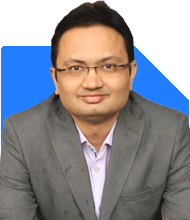Ramalingam Kalirajan |10876 Answers |Ask -Follow
Mutual Funds, Financial Planning Expert - Answered on Jun 21, 2025
He has an MBA in finance from the University of Madras and is a certified financial planner.
He is the director and chief financial planner at Holistic Investment, a Chennai-based firm that offers financial planning and wealth management advice.... more

Hello, I'm 36. Don't have much in saving. 6L in PPF AND PF. I just finish my home loan. Have physical gold around 20L worth. I can save 1.25L every month now that home loan is over. Where should I invest with 5-6 years time line?
Your loan is over. Your savings capacity has increased.
This is the perfect time to build wealth.
Let us create a 360-degree strategy for the next 5–6 years.
Monthly Saving Power After Loan Closure
You now save Rs. 1.25 lakhs every month.
This is a strong surplus amount.
Very few people invest this much consistently.
You already have:
Rs. 6 lakhs in PPF and PF
Rs. 20 lakhs in physical gold
Let us now align your investments with your timeline.
First Step – Clarity of Goals
You said your timeline is 5–6 years.
Let’s understand the purpose behind this timeline.
Is this amount for:
Child’s higher education?
Retirement starting in 6 years?
A big life goal like travel, business, or shifting jobs?
The answer will change your investment structure.
For now, let’s assume you want capital growth with moderate risk.
Your Existing Portfolio Assessment
PPF and PF – Rs. 6 lakhs
These are long-term debt savings.
Good for retirement, not suitable for 5–6 year goals.
Keep contributing, but do not depend on this for short-term needs.
Gold – Rs. 20 lakhs
Physical gold is not liquid.
Cannot be sold quickly during emergencies.
Also, no regular income is generated.
Price can stay flat for many years.
This gold can be kept as reserve.
But not considered active investment.
Do Not Use Real Estate or Gold for Short-Term Goals
Please avoid buying another house or land now.
It is illiquid. Difficult to sell when needed.
You cannot rely on rent or resale in 5–6 years.
Gold and property are good stores of value.
But not ideal for short-term growth goals.
Use a Bucket Approach to Invest Rs. 1.25 Lakhs Monthly
To protect your money and grow it well, use three buckets.
Bucket 1 – Low Risk (Rs. 25,000 Monthly)
Use ultra-short-term or short-duration debt funds.
This gives liquidity and safety.
You can use it for emergencies or near-term needs.
You can also park money here for yearly goals.
Why not FD?
Debt funds give better taxation.
FD interest is fully taxable.
Debt funds taxed only when sold.
Also, debt funds offer better post-tax returns.
But remember: Debt fund gains are taxed as per slab.
Bucket 2 – Medium Risk (Rs. 35,000 Monthly)
Use hybrid funds like aggressive hybrid or balanced advantage.
They combine debt and equity.
Suitable for 5–6 year goals.
Offers better stability than pure equity.
This helps reduce sudden fall risk.
And gives better growth than full debt.
Bucket 3 – High Growth (Rs. 65,000 Monthly)
Invest in actively managed equity mutual funds.
Use 3 to 4 funds across categories.
Don’t exceed 4 equity funds total.
Suggested allocation:
Flexi Cap Fund – Rs. 25,000
Multicap Fund – Rs. 15,000
Midcap Fund – Rs. 15,000
Small Cap Fund – Rs. 10,000
Small caps are optional. Only if you are okay with risk.
Keep their allocation less than 15%.
Avoid sectoral or thematic funds.
Also avoid international funds.
They don’t suit short timelines.
SIP vs Lumpsum in This Case
SIP works best for you now.
Because your monthly surplus is fixed.
You don’t have a large lump sum today.
Start SIPs in all the above funds.
And run them for at least 5 years.
Increase SIP yearly if income grows.
Don’t Use Index Funds for This Goal
You may hear index funds are cheaper.
But they just copy the market.
They can’t exit bad-performing stocks.
They offer no downside protection.
You need expert fund management now.
Actively managed funds offer better selection.
They adapt based on economy and sector outlook.
This is important when time is only 5–6 years.
You don’t have time to wait after a crash.
Don’t Use Direct Plans
If you are considering direct mutual funds, please stop.
Problems with Direct Funds:
You will not know when to switch or rebalance.
No expert guidance during market fall.
You may stop SIP in fear.
You can’t track performance effectively.
Instead, use regular funds through an MFD with CFP credential.
Why?
You get portfolio review yearly.
They help track each goal.
They remove underperforming funds.
They help you stick to the plan.
That is more valuable than saving some fee.
Direct funds suit only full-time investors.
You need peace of mind, not complications.
Do You Need Insurance?
You did not mention insurance.
If you don’t have term insurance, buy it today.
Use term plan with coverage of 15–20 times your income.
Avoid any LIC, endowment, or ULIP plans.
Only term plan gives full risk cover at low cost.
If you have LIC or investment insurance plans, surrender them.
Reinvest the proceeds in mutual funds.
Also buy a health insurance policy.
Don’t depend only on employer cover.
Build an Emergency Fund
You are just out of a loan.
You must now build a safety net.
Keep at least Rs. 3 to 4 lakhs in a liquid fund.
Use this only for medical or family emergency.
This will help you stay invested without panic.
Review Investments Every Year
Every year, do these 5 things:
Review each fund’s return.
Check if you are on track for 5–6 year goal.
Remove poor-performing funds.
Rebalance between debt and equity.
Consult with your CFP-MFD for adjustments.
Reviewing regularly is more important than starting fast.
Tax Awareness for Mutual Fund Investors
New tax rules for mutual funds:
Equity LTCG over Rs. 1.25 lakh taxed at 12.5%
STCG from equity taxed at 20%
Debt fund gains taxed as per your income slab
So, sell only when needed.
Let your gains stay and grow.
Avoid frequent withdrawals.
This allows compounding and tax deferral.
What to Avoid Now
Please avoid the below:
Do not invest in gold or more property.
Do not invest in insurance-based plans.
Do not start NPS for this short-term goal.
Do not depend on FD for long-term needs.
Do not delay term or health insurance.
Do not use direct plans without proper advice.
Do not add more than 4 mutual funds.
Keep your portfolio clean and manageable.
Track progress goal-wise, not scheme-wise.
Action Plan Summary
Start SIP of Rs. 1.25 lakhs across 3 buckets.
Build emergency fund of Rs. 4 lakhs in liquid fund.
Buy term insurance immediately.
Get separate health insurance for family.
Do not invest in property again.
Work with CFP-qualified MFD for ongoing review.
Focus on staying invested for 6 years.
This way, you can achieve your goal peacefully.
Without panic or confusion.
Finally
You are debt-free.
Your savings potential is strong.
You are ready to create wealth now.
Focus only on discipline and long-term commitment.
Avoid distractions. Stick to your plan.
Stay invested. Review yearly.
Let compounding do its job.
Best Regards,
K. Ramalingam, MBA, CFP,
Chief Financial Planner,
www.holisticinvestment.in
https://www.youtube.com/@HolisticInvestment
You may like to see similar questions and answers below
Tejas Chokshi | Answer |Ask -Follow
Tax Expert - Answered on Apr 24, 2023
Ramalingam Kalirajan |10876 Answers |Ask -Follow
Mutual Funds, Financial Planning Expert - Answered on May 06, 2024
Ramalingam Kalirajan |10876 Answers |Ask -Follow
Mutual Funds, Financial Planning Expert - Answered on Jun 28, 2024
Milind Vadjikar | Answer |Ask -Follow
Insurance, Stocks, MF, PF Expert - Answered on Nov 07, 2024
Ramalingam Kalirajan |10876 Answers |Ask -Follow
Mutual Funds, Financial Planning Expert - Answered on Apr 17, 2025
Radheshyam Zanwar |6740 Answers |Ask -Follow
MHT-CET, IIT-JEE, NEET-UG Expert - Answered on Dec 09, 2025
Naveenn Kummar |234 Answers |Ask -Follow
Financial Planner, MF, Insurance Expert - Answered on Dec 09, 2025
Ramalingam Kalirajan |10876 Answers |Ask -Follow
Mutual Funds, Financial Planning Expert - Answered on Dec 09, 2025
Ramalingam Kalirajan |10876 Answers |Ask -Follow
Mutual Funds, Financial Planning Expert - Answered on Dec 09, 2025
Radheshyam Zanwar |6740 Answers |Ask -Follow
MHT-CET, IIT-JEE, NEET-UG Expert - Answered on Dec 09, 2025
Radheshyam Zanwar |6740 Answers |Ask -Follow
MHT-CET, IIT-JEE, NEET-UG Expert - Answered on Dec 09, 2025
Nayagam P P |10853 Answers |Ask -Follow
Career Counsellor - Answered on Dec 09, 2025
Mayank Chandel |2569 Answers |Ask -Follow
IIT-JEE, NEET-UG, SAT, CLAT, CA, CS Exam Expert - Answered on Dec 08, 2025
Mayank Chandel |2569 Answers |Ask -Follow
IIT-JEE, NEET-UG, SAT, CLAT, CA, CS Exam Expert - Answered on Dec 08, 2025

Mayank Chandel |2569 Answers |Ask -Follow
IIT-JEE, NEET-UG, SAT, CLAT, CA, CS Exam Expert - Answered on Dec 08, 2025
























